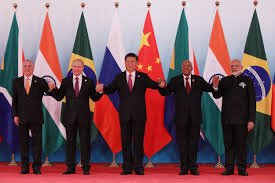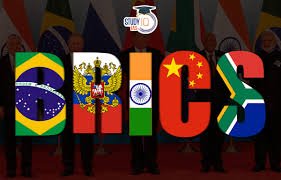Introduction of BRICS Nations:
The BRICS nations—Brazil, Russia, India, China, and South Africa—represent a group of emerging economies that have grown increasingly influential in global affairs. Established as an informal grouping in 2001 and later formalized, BRICS nations has become a significant force for promoting cooperation among its members and advocating for a multipolar world order. This article explores the history, objectives, achievements, and challenges of BRICS while examining its role in reshaping global geopolitics and economics.

- The Genesis of BRICS
1.1 The Origin of the Concept
The acronym “BRIC” was first coined by Jim O’Neill, an economist at Goldman Sachs, in 2001. It referred to four fast-growing economies—Brazil, Russia, India, and China—that were projected to dominate the global economy in the 21st century. These countries shared characteristics such as large populations, expansive territories, and significant potential for economic development.
1.2 Inclusion of South Africa
In 2010, South Africa was invited to join the grouping, and BRIC became BRICS. South Africa’s inclusion was strategic, ensuring representation from Africa, a continent rich in resources and potential.
- Objectives of BRICS
BRICS was established to create a platform for cooperation and mutual support among its member countries. Its primary objectives include:
- Promoting Economic Growth: Enhancing trade, investment, and economic partnerships.
- Advocating for a Multipolar World: Challenging the dominance of traditional Western powers in global governance.
- Fostering Innovation and Technology Sharing: Encouraging collaboration in science, technology, and innovation.
- Addressing Global Challenges: Coordinating efforts to tackle climate change, food security, and health crises.
- Strengthening Regional and International Influence: Representing the interests of developing nations in multilateral forums.
- Economic Significance of BRICS
3.1 Contribution to Global GDP
BRICS countries collectively account for approximately 40% of the world’s population and over 25% of global GDP. Their economies are diverse, ranging from manufacturing and technology in China to energy resources in Russia and agriculture in Brazil.
3.2 Trade and Investment
The intra-BRICS trade volume has steadily increased, with members seeking to reduce dependence on Western markets. The BRICS countries also attract significant foreign direct investment (FDI) due to their growth potential.
3.3 Establishment of the New Development Bank (NDB)
One of BRICS’ most notable achievements is the establishment of the New Development Bank in 2014. Based in Shanghai, the NDB provides financial support for infrastructure and sustainable development projects in BRICS and other emerging economies.

- Political and Strategic Dimensions
4.1 Global Governance Reform
BRICS has consistently advocated for reforming global institutions like the United Nations, International Monetary Fund (IMF), and World Bank to reflect the shifting balance of power. The group seeks greater representation for developing nations in decision-making processes.
4.2 South-South Cooperation
BRICS emphasizes the importance of South-South cooperation—collaboration among developing countries—as a means to reduce dependency on developed nations.
4.3 Geopolitical Stance
While BRICS members have different political systems and foreign policies, they share a common goal of reducing Western dominance. This alignment has driven initiatives in areas such as cybersecurity, space exploration, and defense.
- Social and Cultural Exchange
5.1 People-to-People Ties
BRICS promotes cultural exchanges and people-to-people connections through initiatives like youth summits, cultural festivals, and academic partnerships. These activities foster mutual understanding and goodwill among member states.
5.2 Education and Research
Collaboration in education and research is a key priority. Programs like the BRICS Network University facilitate academic exchanges and joint research projects in fields such as energy, water resources, and public health.
- Achievements of BRICS
6.1 New Development Bank
The NDB has approved billions of dollars in funding for projects in renewable energy, urban development, and transport infrastructure, boosting sustainable development across member states.
6.2 Contingent Reserve Arrangement (CRA)
The CRA, established in 2015, provides a safety net for member countries facing short-term balance-of-payments issues. This initiative demonstrates the group’s commitment to financial stability.
6.3 Influence in Multilateral Forums
BRICS nations has become a strong voice in global forums like the G20, advocating for policies that support the interests of developing nations. Its members have also coordinated positions on critical issues such as climate change and digital governance.
- Challenges Facing BRICS
7.1 Internal Diversity
The BRICS nations are highly diverse in terms of culture, political systems, and economic structures. These differences can sometimes hinder consensus and collective action.
7.2 Geopolitical Tensions
Bilateral tensions, such as those between India and China, pose challenges to BRICS unity. Managing these differences is essential for the group’s effectiveness.
7.3 External Pressures
BRICS faces skepticism and criticism from Western countries, which view the group’s initiatives as a challenge to established global norms.
7.4 Economic Disparities
The economic performance of BRICS members has varied significantly in recent years. While China and India have maintained robust growth, Brazil, Russia, and South Africa have faced economic challenges.

- The Future of BRICS
The future of BRICS depends on its ability to adapt to changing global dynamics and leverage its collective strengths. Potential areas of focus include:
- Green Energy Transition: Expanding cooperation in renewable energy technologies to address climate change.
- Digital Economy: Promoting digital innovation and bridging the digital divide.
- Health and Pandemic Preparedness: Strengthening health systems and collaborating on vaccine research and distribution.
- Expansion of Membership: Considering the inclusion of new members to enhance the group’s global reach.
- Conclusion
The BRICS nations have emerged as a pivotal force in global affairs, advocating for greater inclusivity and equity in the international system. Despite challenges, the group’s achievements in economic, political, and social spheres underscore its potential to shape the future of global governance. As the world continues to evolve, BRICS will likely play a critical role in promoting a more balanced and multipolar world order.
Through sustained cooperation and strategic initiatives, BRICS aims to empower its members and provide a collective voice for developing nations. Its success will depend on its ability to navigate internal differences and external pressures while fostering a shared vision for growth and development.
